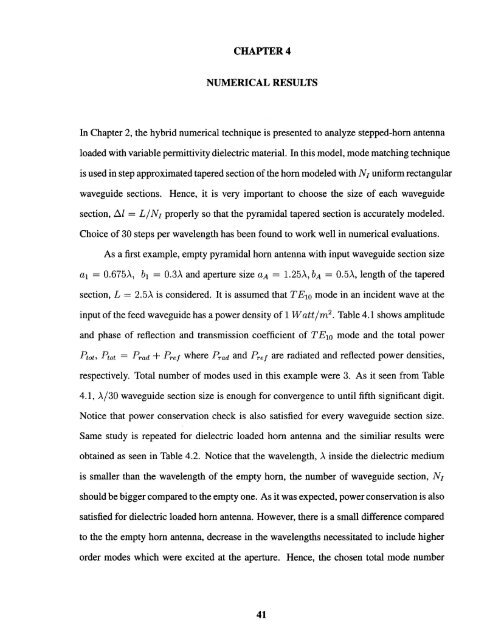Variable permittivity dielectric material loaded stepped-horn antenna
Variable permittivity dielectric material loaded stepped-horn antenna
Variable permittivity dielectric material loaded stepped-horn antenna
You also want an ePaper? Increase the reach of your titles
YUMPU automatically turns print PDFs into web optimized ePapers that Google loves.
CHAPTER 4NUMERICAL RESULTSIn Chapter 2, the hybrid numerical technique is presented to analyze <strong>stepped</strong>-<strong>horn</strong> <strong>antenna</strong><strong>loaded</strong> with variable <strong>permittivity</strong> <strong>dielectric</strong> <strong>material</strong>. In this model, mode matching techniqueis used in step approximated tapered section of the <strong>horn</strong> modeled with NI uniform rectangularwaveguide sections. Hence, it is very important to choose the size of each waveguidesection, A/ = L/NI properly so that the pyramidal tapered section is accurately modeled.Choice of 30 steps per wavelength has been found to work well in numerical evaluations.As a first example, empty pyramidal <strong>horn</strong> <strong>antenna</strong> with input waveguide section sizeal = 0.675A, b1 = 0.3A and aperture size aA = 1.25A, bA = 0.5A, length of the taperedsection, L = 2.5A is considered. It is assumed that TE10 mode in an incident wave at theinput of the feed waveguide has a power density of 1 Watt/m² . Table 4.1 shows amplitudeand phase of reflection and transmission coefficient of TE10 mode and the total powerPtot, Ptot = Prad Pref where Pradand Pre f are radiated and reflected power densities,respectively. Total number of modes used in this example were 3. As it seen from Table4.1, A/30 waveguide section size is enough for convergence to until fifth significant digit.Notice that power conservation check is also satisfied for every waveguide section size.Same study is repeated for <strong>dielectric</strong> <strong>loaded</strong> <strong>horn</strong> <strong>antenna</strong> and the similiar results wereobtained as seen in Table 4.2. Notice that the wavelength, A inside the <strong>dielectric</strong> mediumis smaller than the wavelength of the empty <strong>horn</strong>, the number of waveguide section, NIshould be bigger compared to the empty one. As it was expected, power conservation is alsosatisfied for <strong>dielectric</strong> <strong>loaded</strong> <strong>horn</strong> <strong>antenna</strong>. However, there is a small difference comparedto the the empty <strong>horn</strong> <strong>antenna</strong>, decrease in the wavelengths necessitated to include higherorder modes which were excited at the aperture. Hence, the chosen total mode number41
















